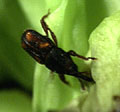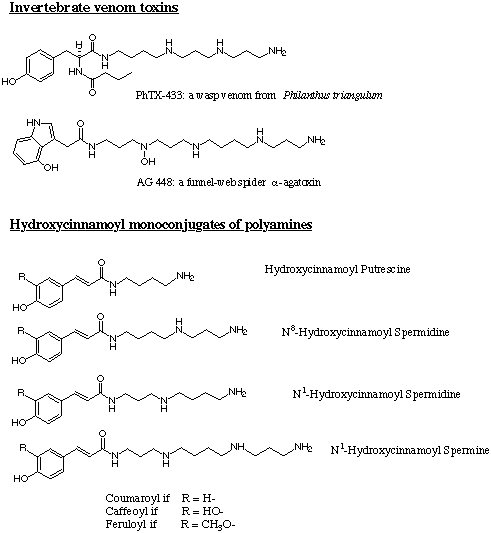Many
plants contain natural products (or secondary chemicals)
which confer resistance to attack by pathogens such as insects
and fungi. Since plants cannot run away from their enemies they
must protect themselves chemically to a certain degree. For instance,
phenols and phenolic acids are known to play an important role
in a plant's defensive repetoire. It has been shown that the total
phenolic content of corn plants and kernels is a good descriptor
of the resistance to the European corn borer (ECB) Ostinia
nubilalis (right) one of the most significant pests of corn
and peppers (below) in North America.
Damage done to sweet peppers is particularly
important because of the value of the crop and the rather insidious
way that the ECB eats its way into the stalk of the developing
fruit and spends most of its time inside the pepper (see left),
out of the reach of insecticidal sprays. Even very low infestation
rates will drastically lower the farm gate value of the crop if
not make it unsellable.
 Recent work investigating the role of phenolic
acids in the resistance of corn to various insect pests has shown
that when plants conjugate these acids to polyamines their biological
activity is enhanced. At concentrations representative of those
found in resistant corn varieties, ferulic and coumaric acid conjugates
of putrescine have been shown to be toxic to Sytophilus zeamais,
a pest of stored corn. Curiously, these compounds have also been
determined to be anti-fungal towards three virulent strains of
Fusarium graminiarum at biologically relevant concentrations.
Recent work investigating the role of phenolic
acids in the resistance of corn to various insect pests has shown
that when plants conjugate these acids to polyamines their biological
activity is enhanced. At concentrations representative of those
found in resistant corn varieties, ferulic and coumaric acid conjugates
of putrescine have been shown to be toxic to Sytophilus zeamais,
a pest of stored corn. Curiously, these compounds have also been
determined to be anti-fungal towards three virulent strains of
Fusarium graminiarum at biologically relevant concentrations.
The Colorado potato beetle (left) is one
of the most pesticide resistant insects in North American agriculture.
Current control measures on potatos and tomatoes are costly and
imperfect. While some excellent resistant potato and tomato varieties
have been developed (they have hairy leaves or toxin exuding glands
on the leaf surfaces) there is much room for improvement. Perhaps
the polyamine conjugates can have a role in this aspect of plant
protection.
The mode of action of these compounds is
not known, nor have many analogues been synthesized or tested
in biological assay. We have noted that the polyamine conjugates
found in corn and several Solanaceous plants such as tomato
(right) potato and tobacco, bear a strong similarity to acylpolyamines
isolated from spider and wasp toxins. These toxins are known to
act on invertebrates by antagonizing ion-gated channel proteins
in the muscle membrane. We have now shown that polyamine conjugates
from plants and synthetic analogues also act as invertebrate neurotoxins
by acting on crustacean and insect ion channels.

To allow a complete assesment of their biological activity it is necessary to synthesize several of the most abundant conjugates. General synthetic methods have been described for some of these materials, but for a more complete understanding of structure and activity it would be necessary to synthesize some non-natural analogues. This would include reduction of the unsaturated acids, alkylation at the alpha and bets positions, changing the position and type of aromatic substituents, and alkylation of the amide and amino nitrogens. The relative simplicity of the compounds and the previous development of some synthetic approaches makes this a realistic goal for a project of this type. The newly proposed analogues, however, would provide the student with some experience in peptide chemistry, protecting groups, chemical selectivity (especially in the case of the spermidine and spermine analogues), and the rationale of structure activity investigations.
In order to make a case for growing plants that can better protect themselves against insect and fungal attack it is necessary to explore the natural variation in the occurrence of the compounds of interest in live plants grown under field and greenhouse conditions. In order to determine whether these conjugates have any chemical-ecolgical relevance, we would like to analyze there concentrations in different tissues from plants that are healthy and those that have been preyed apon by herbivorous insects, or been infected with micorbial pathogens.
All plant samples must be screened for the presence and concentration of polyamine conjugates. This is made easier by our having synthetic standards. Analysis will be performed by high performance liquid chromatogrpahy (HPLC) using an ion-pairing technique that eliminates any need for sample derivatization. State of the art chromatography software allows statistical treatment of samples and the easy quantitative determination of the conjugates. The student in this project would learn modern liquid chromatography and sample preparation techniques, introductory statistics for biological data treatment, and various elements of plant chemistry and physiology.